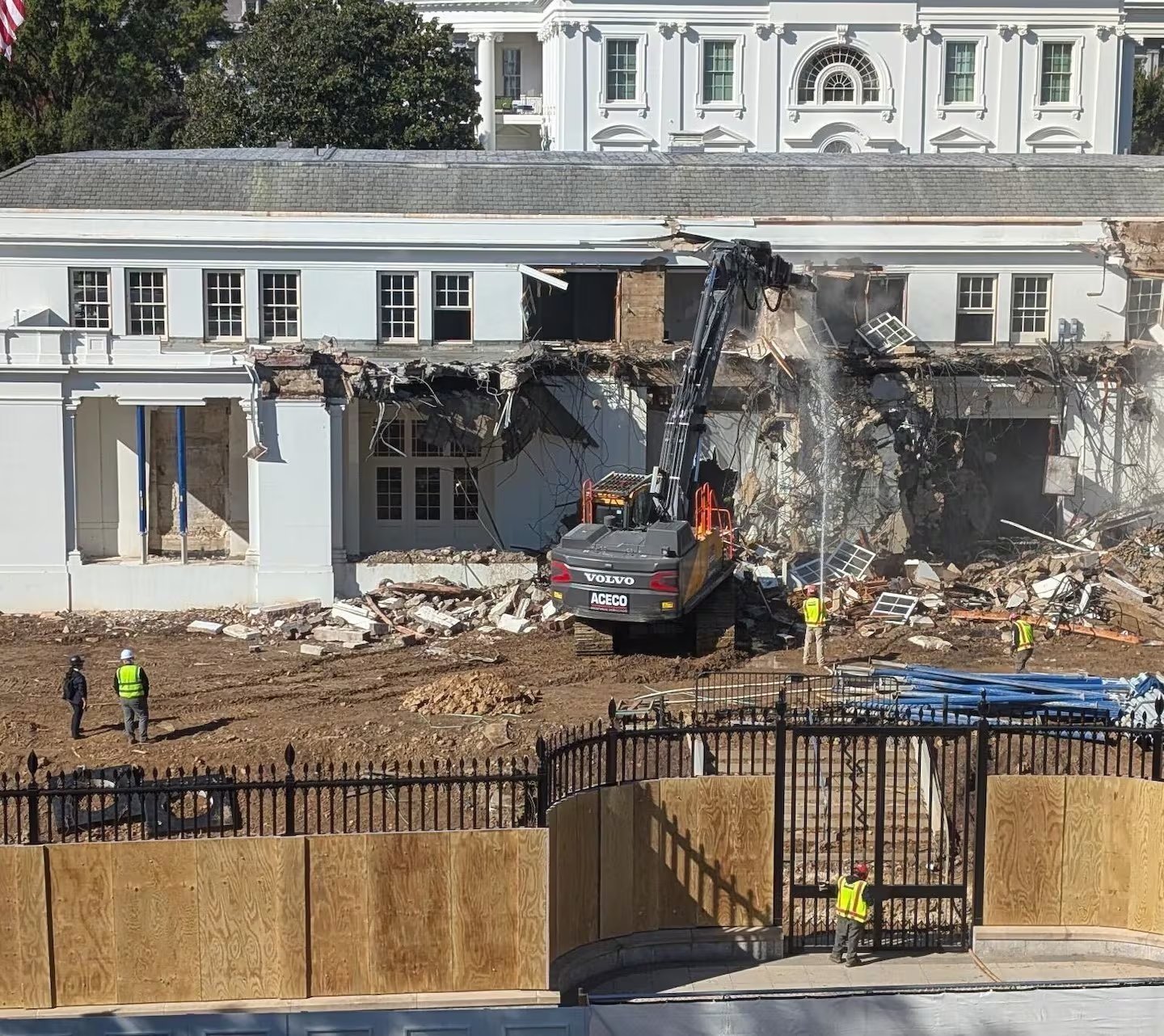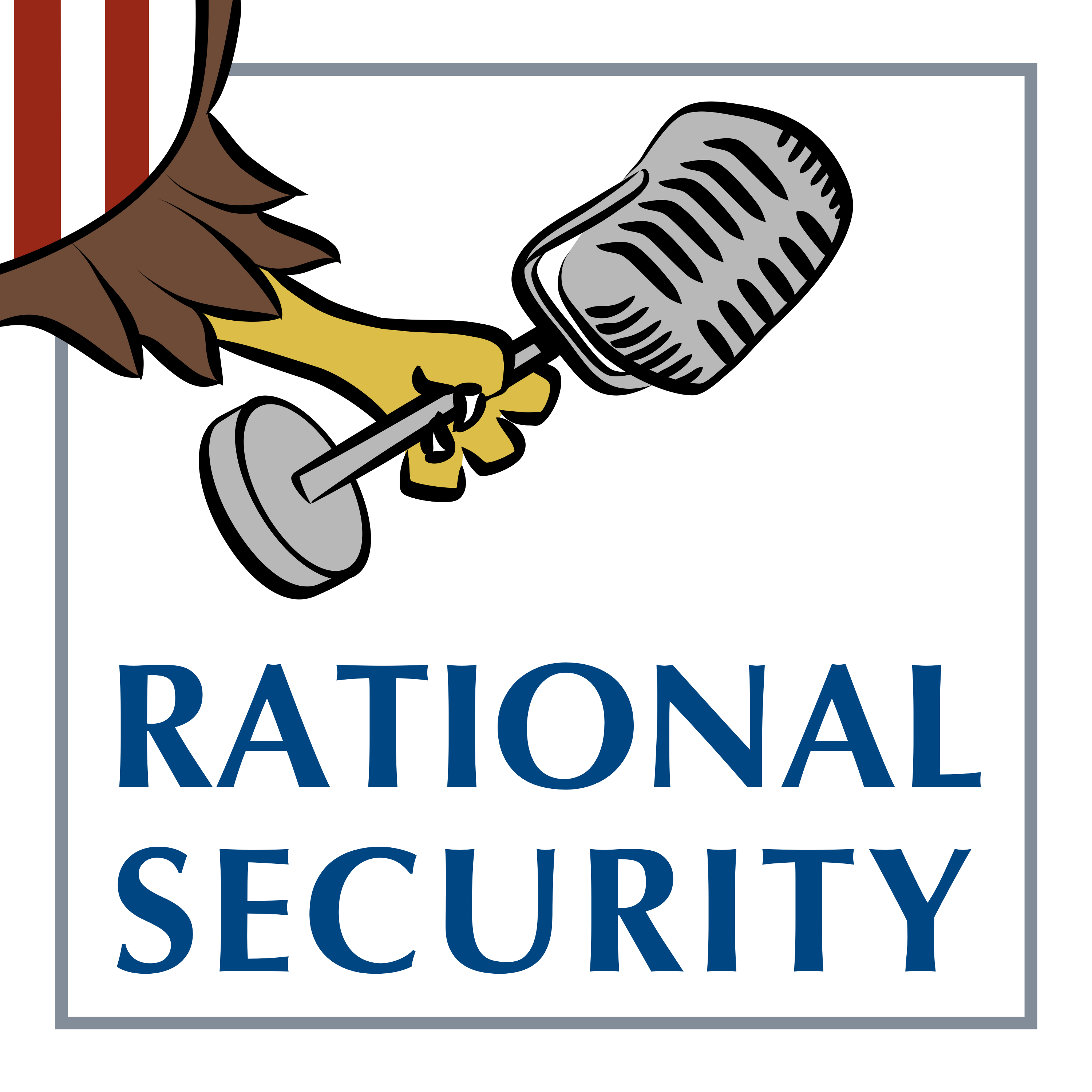Trump’s Demolition Derby

Published by The Lawfare Institute
in Cooperation With

The National Trust for Historic Preservation presented a request to President Trump last week regarding the East Wing of the White House: “We respectfully urge the Administration and the National Park Service to pause demolition until plans for the proposed ballroom go through the legally required public review processes.”
The missive looks positively quaint next to the images that appeared the same day of the structure in question, its facade obliterated by a large backhoe.
“Nothing will be torn down,” press secretary Karoline Leavitt said this summer, when the White House announced a 90,000-square-foot state ballroom would soon abut the East Wing. This grandest of additions, the president proclaimed on Truth Social, would come not at taxpayers’ expense but “compliments of a man known as Donald J. Trump.”
Neither promise has turned out to be true. Something, obviously, was torn down: The century-old East Wing is now “only a memory,” as the lead headline on the front page of Friday’s Washington Post put it. Gone are the offices of the First Lady; the garden Ladybird Johnson planted and named after her predecessor Jackie Kennedy; the rooms in which White House calligraphers inked intricate invitations; the entrance through which most everyday citizens walked to tour the most famous home in the country.
And Donald J. Trump isn’t paying for the ballroom—at least not for all of it. He now says construction will be privately funded by “many generous Patriots, Great American Companies, and, yours truly” (emphasis added). Many of those generous patriots and great companies attended a dedicated fundraising dinner in the East Room this month.
The physical destruction of a portion of the White House may seem a frivolous matter to focus on when compared to the prosecutions of a state attorney general and a former FBI director, the National Guard on the streets of U.S. cities, or military strikes in the Caribbean. But the $200 million—wait, now $300 million—ballroom-to-be in all its gilded glory encapsulates many of the same abuses that have defined this presidency.
Very Much in Keeping With the Magnificent White House Itself
“For 150 years, presidents, and many others, have wanted a beautiful ballroom, but it never got built because nobody previously had any knowledge or experience in doing such things,” Trump posted on Truth Social in June. “But I do, like maybe nobody else, and it will go up quickly, and be a wonderful addition, very much in keeping with the magnificent White House itself.”
While none of Trump’s predecessors may have built a “beautiful ballroom,” at least by the president’s aesthetic standards, past leaders left their mark in other ways. The White House obviously didn’t spring fully formed from the head of George Washington. Today’s building is something of a collaboration among the 45 men who’ve occupied it. Thomas Jefferson added colonnades (extravagant, critics complained); James Monroe built the South Portico; Andrew Jackson added the North Portico (expensive, griped some editorialists); the West Wing comes from Theodore Roosevelt and the East Wing from Franklin D.
Most dramatically, Harry S. Truman embarked in 1948 on an extensive gutting of the White House’s interior. The renovation was supposed to address the mansion’s structural unsoundness, and it did—but Truman couldn’t resist adding the now-iconic balcony on the South Portico. Again, the move prompted public outcry. But Congress appropriated the money for the four-year-long facelift, and the National Capital Planning Commission and the Commission of Fine Arts oversaw its carrying out.
This is where the Trump administration’s current renovation departs significantly from convention. This time, no consultation has taken place at all. (These departures are not limited to physical infrastructure. A timeline of the White House on its official website now includes changes to the building throughout the years, which begins with historical examples before proceeding to, among other politically charged additions, speculation that Hunter Biden was responsible for a bag of cocaine discovered in the West Wing entrance lobby. These subjective insertions to a feature masquerading as a factual resource from an official source will now not only appear to visitors to the page but also likely be included in AI-generated internet summaries.)
Section 106 of the National Historic Preservation Act (NHPA) mandates that federal agencies undergo a thorough review process for projects that could have an effect on historic properties—including consulting appropriate parties (54 U.S.C. § 306108). The key parties in the District of Columbia are the National Capital Planning Commission (NCPC) and, in an advisory capacity, the Commission of Fine Arts. Typically, the NCPC would assess the adverse impact a project might have as part of the mandatory NHPA process and approve the project only after the applicant had satisfactorily resolved any problems.
The White House could nitpick and say it isn’t a federal agency, but the Presidential Residence Act puts it under the management of the National Park Service, which is. There’s a rub, though: Section 107 of the same act explicitly exempts the White House, Capitol, and Supreme Court from the NHPA review process (54 U.S.C. § 307104).
That doesn’t necessarily mean the NCPC has no authority at all over external alterations to the White House. The body’s enabling statute endows it with approval authority of “federal agency projects that include, without limitation, buildings, uses, structures and signage on federally-owned land in Washington, D.C.” (40 U.S.C. § 8722). Furthermore, Executive Order 11593 requires federal agencies to ensure that “sites, structures and objects of historical, architectural or archaeological significance are preserved, restored and maintained for the inspiration and benefit of the people.” Previous administrations have run their projects—including a perimeter fence replacement and a tennis pavilion—by the NCPC.
These rules and this precedent may explain why Trump and his team so far haven’t mentioned the White House being legally exempted from consulting the NCPC. Instead, they are arguing that they do have to consult the commission—but not yet. This is supposedly because the East Wing is only being torn down, and no ballroom is yet being built up. They claim the NCPC deals only with “construction.”
Destruction, meanwhile, is apparently a free-for-all: A reporter asked Leavitt, “Can the president tear down anything he wants without oversight, can he demolish this building or say, the Jefferson Memorial?” Leavitt replied that the NCPC had determined that “when it comes to phase one of this project, the tearing down of the current East Wing structure, a submission is not required legally for that—only for vertical construction will a submission be required.”
The logical (or illogical) upshot of this stance is that the president may turn the National Mall into a series of gaping holes in the ground if he so pleases. He just can’t necessarily fill them with anything once he’s done.
Ultimately, Leavitt is right that the NCPC is on board with the administration’s interpretation of the law, absurd or not. The body’s chairman has endorsed the position that its jurisdiction extends only to “vertical build.” And why wouldn’t he? The chairman, Will Scharf, is also White House staff secretary. The majority of the rest of the 12-member NCPC—traditionally comprised of architects and experts in civic planning—are also the president’s handpicked allies.
The demise of historic preservation protections may not seem like the worst blow democracy has suffered of late. But the manner in which the White House has side-stepped rules and norms by co-opting the relevant portion of the government, all in order to facilitate a presidential whim, should be familiar to anyone tracking graver harms.
Compliments of a Man Known as Donald J. Trump
The question of whether Trump can build his ballroom is distinct from the question of how he can do it—or, more precisely, how he can fund it.
Without an appropriation from Congress—and the accompanying strings that the president may not want Capitol Hill pulling—the Appropriations Clause of the Constitution is clear that Trump can’t draw on Treasury funds. The Anti-Deficiency Act accordingly prohibits unauthorized or excessive government expenditures (31 U.S.C. § 1341). Again, the White House might claim this law doesn’t apply to it—even though previous administrations have abided by its strictures. But here, the National Park Service’s role leading the project guarantees the rules do count. By using government contractors or paying anyone with government money, the administration would violate the law.
That means that any paychecks today must truly be coming out of either the president’s pocket, or the pockets of the private donors he has mentioned. There’s really no way of knowing whether that’s what’s happening, because the White House hasn’t disclosed any relevant information. But take Trump at his word, and there’s still a potential problem: The Anti-Deficiency Act also prohibits agencies from “accept[ing] voluntary services” or “employ[ing] personal services” not authorized by law (31 U.S.C. § 1342).
The only exception to the rule is for “emergencies involving the safety of human life or the protection of property.” There’s no plausible argument that anyone’s safety would be in jeopardy were the president not allowed to raze a third of the White House and replace it with a ballroom—and, obviously, the protection of property isn’t at issue either. The prohibition, then, would seem to cover the solicitation and acceptance of outside donations for the project.
Again, however, a legal loophole opens wide for Trump: Among the statutes governing the National Park Service are provisions that enable the agency to receive gifts (54 U.S.C. § 1011).
Over the years, it has—including for projects in Washington. The Vietnam Veterans Memorial was funded by private donors. (It is worth noting that 250,000 individuals and corporations chipped in to raise a total of $8.4 million, while the donors at the White House dinner dedicated to the ballroom numbered 128.) The Martin Luther King, Jr. Memorial drew in $110 million in private donations to supplement $10 million in federal funding. Even the Washington Monument relied on private donations. Indeed, the arrangement stalled its construction for a time, when the charitable society in charge was taken over by the Know-Nothing Party and so alienated many of its contributors.
This gift-taking authority explains why the administration—led by top MAGA fundraiser Meredith O’Rourke—is working with the Trust for the National Mall to take in donations. The gifts the National Park Service is permitted to accept are supposed to support the mission and activities of the service, and one might think that an opulent entertainment hall for wealthy citizens and foreign dignitaries rather than the everyday American doesn’t fit the bill. Nonetheless, the Office of Legal Counsel found authority in an older version of one of the National Park Service statutes for the installation of a swimming pool on the South Lawn in 1974, during Gerald Ford’s administration.
It’s not difficult to imagine Trump’s thinking: If Ford could have a pool, why can’t he have a ballroom fit for a palace?
Many Generous Patriots
“So many of you have been really, really generous,” the president said at his ballroom fundraising event this month. “A couple of you are sitting here, saying, ‘Sir, would $25 million be appropriate?’ I said, ‘I’ll take it.’”
Whether anyone has yet shelled out $25 million is unclear, but a $22 million contribution from YouTube, directed to the project as part of a legal settlement with Trump after he sued the platform for removing his account following the Jan. 6 insurrection at the U.S. Capitol, is forthcoming. So, too, is a separate $5 million donation from Google, as well as $10 million from Lockheed Martin. Also attending the dinner were Blackstone CEO Stephen A. Schwarzman, as well as representatives from Amazon, Apple, Meta, Microsoft, and Palantir Technologies, plus bigwigs in industries from oil to tobacco to telecoms.
Manifold cryptocurrency entrepreneurs and investors were present at the event, too. That was fitting, considering how crypto has played an outsized role in this administration, and in the Trump family business in particular. Consider the $TRUMP memecoin, a digital token with no functional purpose that secured top holders an invitation to dinner at one of the president’s golf clubs. Or World Liberty Financial, a decentralized finance firm that issues a stablecoin through which an Abu Dhabi-backed fund has effectively funneled the First Family $2 billion. This exchange also involved blockchain exchange Binance, whose founder, Changpeng Zhao, was pardoned by the Trump administration last week for money laundering and facilitating terrorist finance.
The payments to Trump’s crypto businesses, as Lawfare Editor-in-Chief Benjamin Wittes has written, may well violate federal gratuities laws. The case is harder to make for the ballroom gift-givers. CBS reports that they will earn “recognition” possibly consisting of their names etched in brick or stone. But, given the president’s fondness for scratching the backs of those who scratch his, it isn’t difficult to imagine the more substantial perks, from contracts to friendly policies to lack of unfriendly lawsuits, the ballroom benefactors may receive.
The donations to the Trust for the National Mall would violate federal bribery laws only if they were made as a quid pro quo for a specific “official act” (18 U.S.C. § 201(b)). They might have a greater chance of violating federal gratuities laws, which requires—according to the 1999 Supreme Court case U.S. v. Sun Diamond Growers of California—proving some form of “link between a thing of value conferred upon a public official” and a particular identifiable act (18 U.S.C. § 201(c)).
But even then, a prosecution would be a stretch—under this Justice Department especially, but also under past ones. Prosecutors would have to prove the president was the personal beneficiary of the ballroom, for starters. Not only is the connection between the gift and any theoretical favor in this case awfully attenuated (money is going from the donor, to the Trust for the National Mall, to the National Park Service), but the funds are also ending up in the hands of the government rather than any private individual.
This may, then, be an example of technically permissible pay-to-play—in line with the technically permissible destruction of the East Wing, and the technically permissible payment mechanism for the project. None of these seem like they should be allowed in a representative democracy made up of three coequal branches. And yet, somehow, they probably are.
The president certainly thinks so. Speaking about how easy it was for him to begin demolishing the East Wing, he recalled, “They said, ‘Sir, you can start tonight’ ... ‘This is the White House. You’re the president of the United States. You can do anything you want.’”


.jpg?sfvrsn=5a43131e_9)

